#recycling textile
Text
The urban textile waste supply chain arrives at Ecomondo

The event for the ecological transition is scheduled for 7 to 10 November in Rimini. At the Unirau-Ariu exhibition space, guided tours to discover how this important fraction of urban waste collection is collected, selected and valorised.
Not long left for Ecomondo, the event for the ecological transition scheduled from 7 to 10 November at the Rimini fair.[1] Unirau (the Association of companies and cooperatives that carry out the collection, selection and valorisation of the textile fraction of urban waste) and Ariu (the Association of used clothing recoverers) [2] will participate in the event and will animate an exhibition and demonstration space entirely dedicated to urban textile waste management activities.
The aim of the initiative, which will represent in a small way the different phases of collection and treatment of the textile products placed in street containers every day by citizens, is to make institutions, stakeholders, media and public opinion aware of a national industrial chain that operates successfully in collection, selection, preparation for reuse and recycling of used clothing and urban textile waste (in 2021, over 154 thousand tonnes were collected and treated by the entire sector).
At stand 113-308 in pavilion B3, it will be possible to take part in guided tours to closely observe and understand how this important fraction of urban waste collection is collected, selected and valorised, mandatory in Italy from 1 January 2022 and awaiting the next introduction of the EPR (Extended Producer Responsibility) regime.[3] The process starts from the separate waste collection container where the textile waste is delivered, and then moves on to the parts of the waste treatment and valorisation plant, up to the products ready for reuse and the materials intended for recycling obtained from the selection of the separate waste collection.
“Gift or refusal? Legality or illegality? Reuse or recycle? – underlined Andrea Fluttero, president of Unirau – These are some of the questions that emerge when talking about urban textile waste. During Ecomondo, through our exhibition space and participation in in-depth moments on the sector, we intend to shed light on the present and future of this supply chain, destined in the coming years to collect and manage in an industrial, efficient and traceable way a growing flow of waste which would otherwise generate economic and environmental costs for our country".
“We are a consolidated industrial supply chain integrated with the collection – concludes Joseph Valletti, president of Ariu – we know how to select and valorise the collections well and we are available to future consortia of producers to guarantee effectiveness and efficiency by identifying together the links on which it will be appropriate to direct the resources coming from the extended producer responsibility regime".
Source
Redazione, La filiera dei rifiuti tessili urbani sbarca a Ecomondo, in La Repubblica, 17-10-2023 https://www.repubblica.it/economia/rapporti/energitalia/trasformazione/2023/10/17/news/la_filiera_dei_rifiuti_tessili_urbani_sbarca_a_ecomondo-418044327/?ref=search
[1] Read also: https://www.tumblr.com/earaercircular/700616360685961216/at-the-ecomondo-exhibition-in-rimini-ricoeso?source=share
[2] Read also: https://www.tumblr.com/earaercircular/722806752120274944/thanks-to-the-entry-of-the-campania-region-based?source=share&ref=_tumblr
[3] Read also: https://www.tumblr.com/earaercircular/697446169498058752/recycling-regulatory-framework-and-customers-are?source=share&ref=_tumblr
0 notes
Text

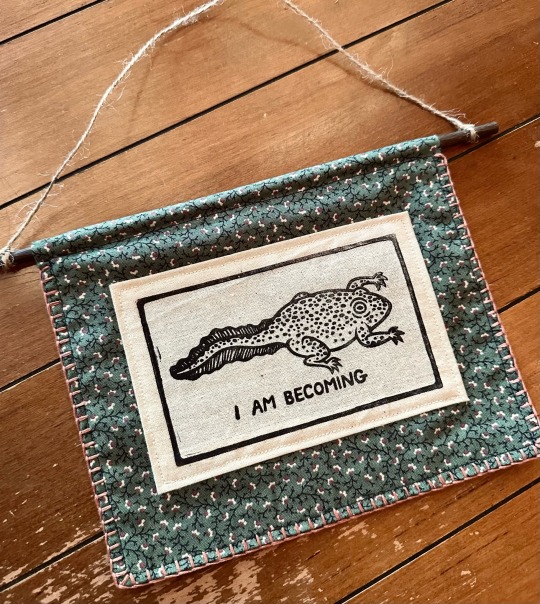
“becoming” banner by jasper alexander
linocut print on fabric, home sewn utilizing recycled textiles
#I am prepping for markets and my body is a constant state of motion#fingers always stitching or carving or packing or typing#linoprint#printmaker#block printing#printmaking#relief print#salted snail studio#block print#reliefprint#blanket stitch#embroidery#mixed media#relief printed fabric#relief printing#fabric printing#creativereuse#recycled textiles#linocut#linocut patch
9K notes
·
View notes
Text
Idea: sew some cute little moths with scrap fabrics and sew them on holes you have on your clothes so you can keep wearing them :)

#diy#sewing#visible mending#textile art#DIY culture#diy punk#sewing ideas#craft ideas#eco fashion#reduce reuse recycle
23K notes
·
View notes
Text
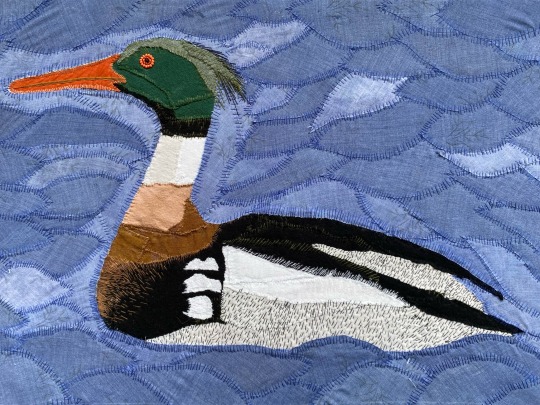
ᓂᑐᐦᑕᒧᐏᐣ nitohtamowin, the act of listening (red breasted merganser)
2024
hand quilted scrap fabric and seed beads
as i worked on this piece at my home on the colonially occupied land of my native ancestors i thought about the words of palestinian poet marwan makhoul;
In order for me to write poetry that isn’t political
I must listen to the birds
and in order to hear the birds
the warplanes must be silent.
—
the colonizing genocidal power that continues to lay waste to my people, keeping us poor, unhoused, and sick is the one of the powers contributing to the genocide of palestinians. Indigenous liberation is intertwined globally, land back for me means land back for us all.
Métis (Otipemisiwak) demand a free Palestine.
#all my work is political because im Indigenous and my identity is inherently politicized in a colonial state#this is in an outdoor/public art gallery!!#don’t love the org i’m working with though…won’t be working with them again lmfao#riel text#my work#red breasted merganser#quilting#contemporary art#Indigenous art#fibre art#textile art#contemporary textiles#textiles#recycled fabric#beadwork#seed beads#art history#artist
439 notes
·
View notes
Text

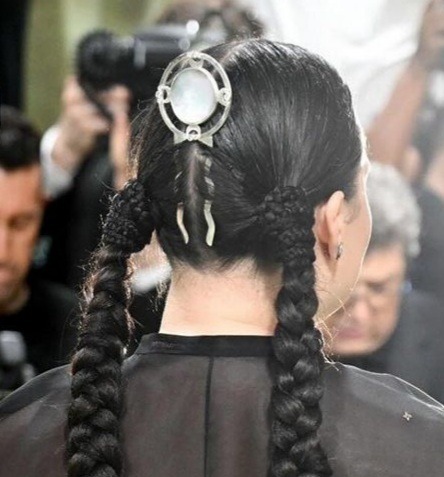
Lily Gladstone at the Met Gala 2024, wearing gown by Gabriela Hearst, and jewellery by Kiowa jeweler Keri Ataumbi.
At first, it seems a rather muted look for the Met Gala, but every detail has significance. Read the story in Vogue.
The gown and cape are embroidered with constellations of recycled silver stars.
“Our ancestors are in the constellations - we're star people.” Keri Ataumbi.
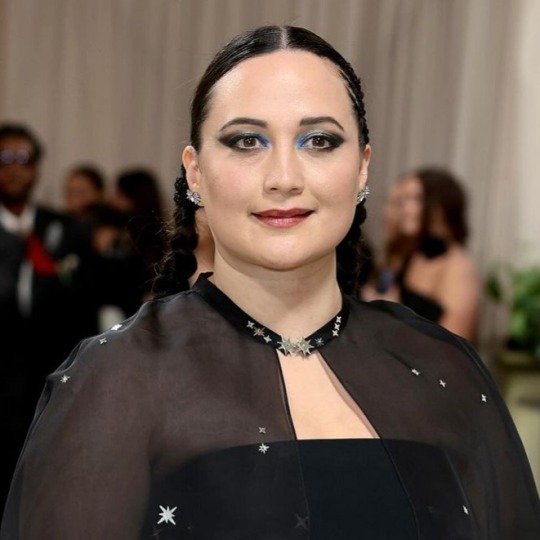
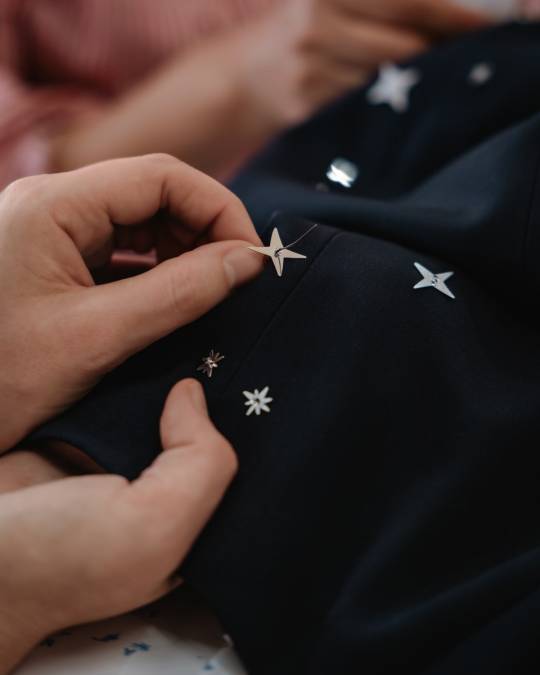
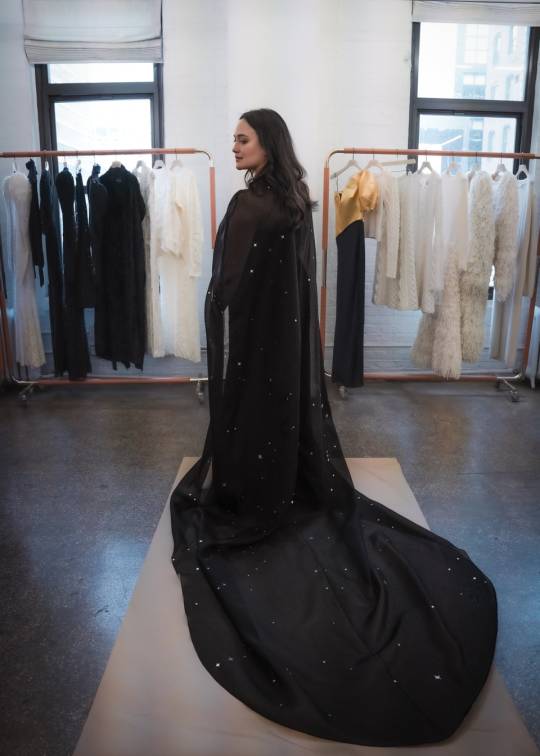
#lily gladstone#red carpet#fashion#met gala 2024#met gala#gabriela hearst#keri ataumbi#us designer#indigenous designer#indigenous actor#cape#star#stars#constellations#great plains#kiowa#surface decoration#pattern#surface pattern#surface pattern design#pattern design#textile design#textiles#2024#celebrity style#celebrity fashion#recycled metal#recycled materials#hair accessories
79 notes
·
View notes
Text
Horror movie leather jacket
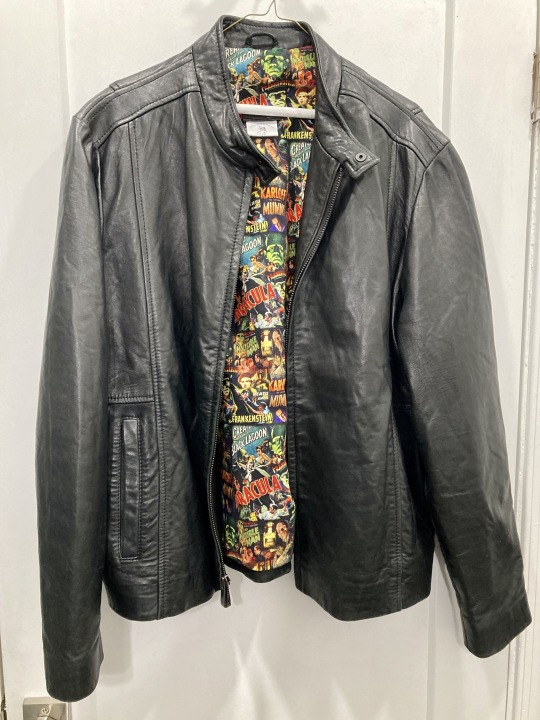
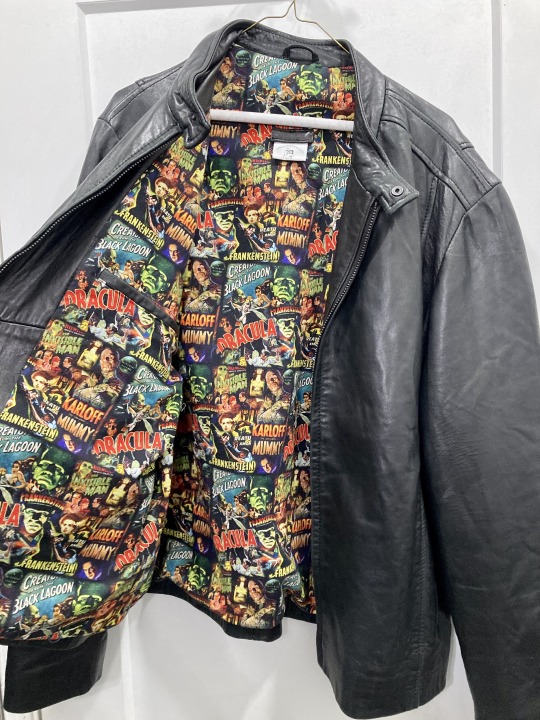
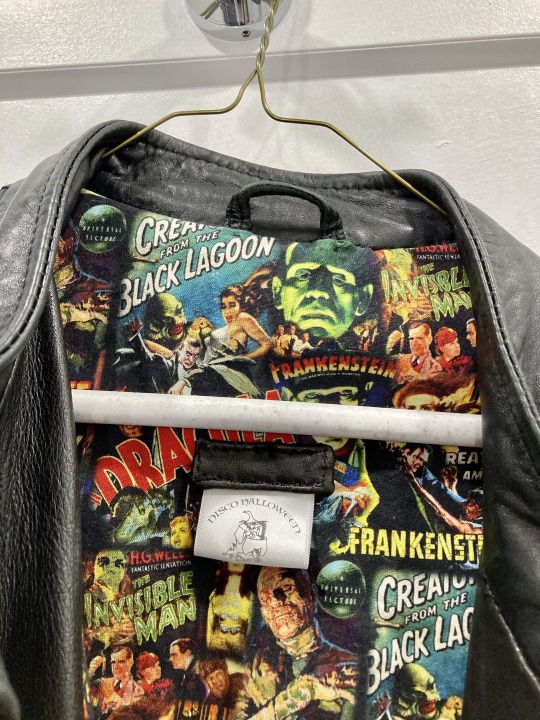

This year's secret santa gift. Thrifted a leather jacket, ripped out the lining, and put in this classic horror movie fabric that I found on Etsy. My friend designed a custom clothing tag for me.
#upcycle#textile#fabric#ecofriendly#recycle#arts and crafts#sustainability#leather#leather jacket#leatherjacket#upcycled#upcycling#recycling#recyled#reduce reuse recycle#horror#horror movies#horror films#horror aesthetic#christmasgifts#christmas#giftideas#presents#holiday#hand sewing#sewing#sew#thrifting#thrift store#thrift finds
998 notes
·
View notes
Text
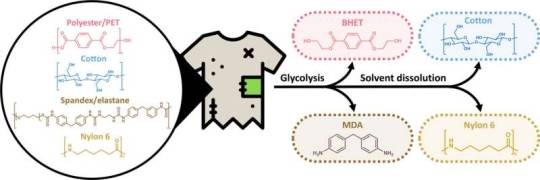
New chemical process separates textile fibers for easier recycling
A combined team of chemical and biomolecular engineers from the University of Delaware, and the Center for Plastics Innovation, both in the U.S., has developed a way to chemically separate fibers in textiles, allowing them to be recycled more quickly and cheaply than conventional methods.
In their paper published in the journal Science Advances, the group describes the process they developed and how well it worked during testing.
Over the past several decades, the evolution of textile production for use in producing clothes has led to what the research team describes as "fast fashion"—where clothes that are considered fashionable by consumers are purchased and worn for a short period of time before being discarded as new fashions appear.
Such clothes have also evolved in a way that has led to the use of multiple types or blends of fibers, which makes recycling them difficult. In this new study, the research team has found a way to chemically separate such fibers so that they can be easily and inexpensively recycled.
Read more.
18 notes
·
View notes
Text

ANTON HENDRIK DENYS
12 notes
·
View notes
Text

#textile recycling#apparel recycling#come ON#we NEED it#make the big brands establish the thing and the small brands can then also use it!!!#let's gooooo#environmental impact
114 notes
·
View notes
Text
organizing shampoo bars
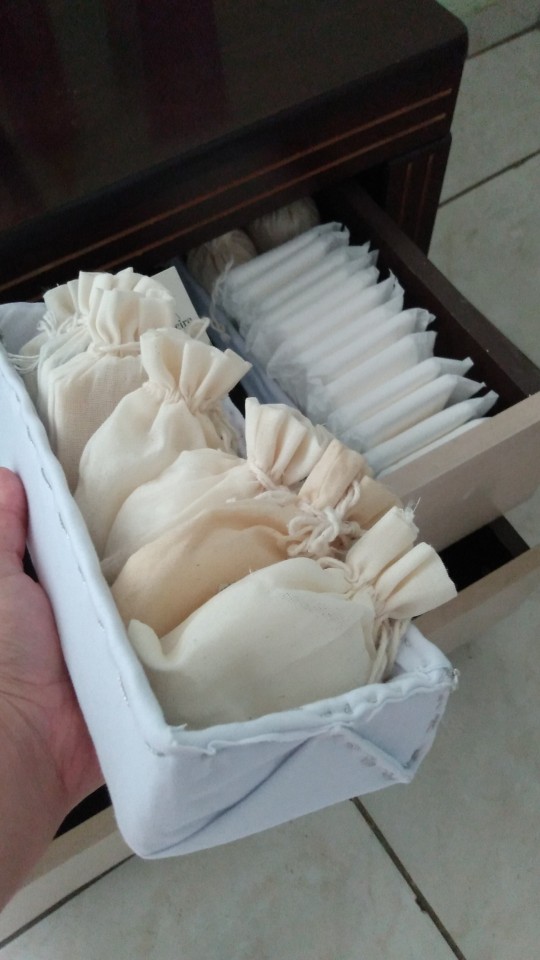

Organizing my shampoo and conditioner bars along with my sanitary pads.
I used a cardboard box, covered with leftover cloth that I sewed by hand.
I am far from perfect zero waste, couldn't adapt to menstrual cups or O.B. or menstrual panties.
However, not being perfect doesn't stop me from trying the best I can in all the rest.
#Reduce the waste#zero waste#zerowaste#sustainability#recycling#recycle#reduce reuse recycle#ecofriendly#earthfriendly#reuse#creative reuse#cardboard box#cardboard cutouts#textile design#textile crafts#textile waste#shampoo and conditioner#shampoo bars#Conditioner bars#Organizing#Organization#Eco cosmetics#eco friendly
35 notes
·
View notes
Text
She Burned It All Down, to Build the Perfect Dress.

Mara Hoffman ditched her successful swimsuit business in order to prioritize sustainability. Nearly a decade later, she’s reaping the rewards.
It looked like a normal dress, a nice one. Something you might wear to a wedding if you wanted to be a bit sexy. It was floor-length, the V-neck plunging into a rosette that swirled and gathered under the bust, and the spaghetti straps crisscrossed on a low-cut back, kind of like a sporty, 1970s swimsuit.
It’s the kind of dress Mara Hoffman, who has been in business for 23 years, could whip up without a second thought. But this particular version has been five years in the making.

Mara Hoffman
“Feel this,” Ms. Hoffman said at her Lafayette Street store in Manhattan[1] one September morning as she held out the coral-coloured fabric. It had the texture of peach skin. “If you go through the store and feel through all of our product, nothing really feels like this.”
The story behind the dress is not sexy — or maybe it is, depending on what you’re into. One of an edition of 35 currently for sale at $1,195, the dress is woven from a proprietary fabric made by a Virginia company called Circ[2], which has patented technology to separate and recycle poly-cotton[3] blends — meaning one part is polyester and one part is cotton — into fibres that can be respun into fabric.
This is a big deal in the world of fabric recycling because, up until now, it has been extremely difficult to break down and recycle blended fabrics, like your old T-shirts, stretch jeans and leggings. “Roughly half of all fabric produced is poly-cotton,” said Peter Majeranowski, the chief executive of Circ.
Circ sources fabric from a few places: factories and mills, which supply shirts that were damaged along the supply chain; charities with an excess of donated clothes; and partners like Patagonia[4] that have a take-back program, in which old clothes are repaired and resold. If those clothes can’t be resold, they go to a warehouse until a solution like Circ comes along.
Ms. Hoffman’s dresses represent what both companies are billing as the first time Circ lyocell fabric[5] is being used for a luxury product, as an alternative to silk, which she has eliminated from her offerings.
“I was longing for the feeling of silk,” Ms. Hoffman said. “It’s always been, how do we speak to this luxury that we really can’t get through our cottons and hemps, the materials that we had safe and vetted access to? What’s our alternative to black tie that isn’t a harmful garment?” In the next three years, Ms. Hoffman has committed to replacing all of the virgin lyocell in her collections with Circ’s recycled version.
Ms. Hoffman first encountered Circ in 2018, when Dana Davis, her vice president of sustainability, product and business strategy, attended the Global Fashion Agenda Summit in Copenhagen. Ms. Davis recalled that Circ’s original technology was developed for tobacco farms that were no longer supplying cigarette manufacturers. She was intrigued.
“We came from the biofuels industry,”[6] Mr. Majeranowski said. “We knew nothing about fashion, and they’ve been patient with us.”
For Ms. Hoffman, the Dress that Changes Everything, as she has christened the style made with Circ, is another chapter in the radical repositioning of her brand that began in 2015. Until then, Mara Hoffman had been the go-to purveyor of sexy psychedelic prints and bikinis for the Coachella crowd. Hers was a robust business that began in 2000 when, as a recent Parsons[7] graduate, she showed up at stores, including Patricia Field in New York, with a bag of clothes she made in her Murray Hill apartment. Her collection was originally called Circle.
“I did a strip show, tried everything on and they placed their first order,” Ms. Hoffman said.
As time wore on, Mara Hoffman the brand felt increasingly disconnected from Mara Hoffman the woman, on a spiritual and aesthetic level. The birth of her son led her to look at the future of the planet differently. “The True Cost,” a 2015 documentary that examined the ravages of fast fashion, shook her. She was disgusted by the overproduction and toxicity that coursed through the industry.
“I couldn’t design what I was designing anymore,” she said.
At one point Ms. Hoffman found herself crying on her couch, telling Ms. Davis that she wanted to close the business. Instead, they committed to an absolute overhaul, shifting from widely distributed hippie prints to a more serene and sophisticated collection — still sexy — with serious sustainability commitments. In the process, they lost half of their retail partners.
“Burn it to the ground,” Ms. Hoffman said. “That’s sort of my style. It’s not for the faint of heart.”
Changing the look of the brand was relatively easy. “I can design something new tomorrow and transform. I’m good at that,” Ms. Hoffman said. More challenging was getting all of her back-of-house sustainable dreams to live up to what the customer was used to. It’s been a process of trial and error, baby steps.
A first order of business was switching to organic and recycled materials whenever feasible. But that is not always possible. “We started working with a system that is still considered a Band-Aid for us, taking plastic bottles, turning them into polyester for our swimwear,” Ms. Davis said. The problem is that once a plastic bottle is turned into swimwear, it’s difficult to recycle from there. Now Ms. Hoffman uses Pyratex[8], a fabric made out of wood pulp with no polyester or nylon, for swimwear.
Ms. Hoffman introduced compostable packaging, but no one knew how to compost it, so the company switched to paper, which people are used to recycling. She started Full Circle[9], the company’s take-back and resale program. She designed extended sizes that went beyond a basic black dress. The stretchy, sexy Popcorn dress — available in a range of colours and silhouettes and in sizes XXS to 3X — was released in 2020 and continues to be a hit.
“It was a swim line before — now it’s a fashion brand,” said Rachael Wang, a former editor and stylist who started working with Ms. Hoffman to shift the visual identity of the brand in 2015. “I think creating a more splashy, fashion-y brand that has this intentionality was exactly what people wanted to see, what people wanted to buy into.”
Ms. Hoffman has run her business independently with no outside investment. But she hasn’t done it alone. Ms. Davis has been with her for 15 years, and they oversee a staff of 25. There’s also the broader sustainability community, of which they are vocal and active members. The Mara Hoffman website is encyclopaedic in its indexing of partners, policies and supply-chain transparency.
Ms. Hoffman was early to fashion’s awakening to the overproduction and climate crises, but she doesn’t consider herself a pioneer. “There were a handful of brands that we were able to see as beacons,” she said, naming Eileen Fisher, Stella McCartney[10] and Patagonia. “They were doing something better.”
Nonetheless, the Circ dresses represent impact, a real change to a system. Next month, Ms. Hoffman will receive the Environmental Sustainability Award from the Council of Fashion Designers of America[11].
“I think we’ve figured out some really important parts that have longevity, so let’s push into that,” Ms. Hoffman said.
Source
Jessica Iredale, She Burned It All Down, to Build the Perfect Dress, in: New York Times, 18-10-2023 ; https://www.nytimes.com/2023/10/18/style/mara-hoffman-dress-sustainable-fashion.html?smid=nytcore-ios-share&referringSource=articleShare
[1] https://marahoffman.com/pages/nyc-store
[2] We are a motley crew of global scientists and business innovators, uniting together to tackle the hardest challenges in science and engineering. Where others see roadblocks, we see an opportunity for applied science. Our team has cracked the code on previously unsolvable textile recycling challenges, busting open doors for even bigger and broader change. https://circ.earth/about-us/
[3] Polycotton is a lightweight widely available fabric, you can get it with prints on but you can also get plain polycotton too. Polycotton is a cheaper alternative to cotton fabrics as it is a blend of both cotton and polyester, natural and synthetic fabrics. Often polycotton fabrics consist of 65% polyester and 35% cotton, but the blend can vary. It combines the breathability of cotton with the durability of polyester. https://www.thesewingdirectory.co.uk/what-is-polycotton/
[4] Read also: https://www.tumblr.com/earaercircular/730359554901180416/patagonia-circular-fashion-and-commitment-to-the?source=share&ref=_tumblr
[5] Read also: https://www.tumblr.com/earaercircular/727074991840067584/lyocell-milk-fibre-and-pineapple-leather-new?source=share&ref=_tumblr
[6] Read also https://www.tumblr.com/earaercircular/706145467107622912/circular-enterprises-what-they-are-and-how-they?source=share&ref=_tumblr & https://www.tumblr.com/earaercircular/653682660781260800/new-amsterdam-port-factory-converts-non-recyclable?source=share&ref=_tumblr
[7] https://www.newschool.edu/parsons/?utm_source=google&utm_medium=cpc&utm_campaign=TNS_Search_Text_Parsons_Brand&gclid=CjwKCAjwnOipBhBQEiwACyGLuhou9rdHONarRYlt6azTTQMi6DmxSVpV3HdauT0mfvl1Zsj2HxeSkRoChT8QAvD_BwE
[8] PYRATEX® is an R&D company and supplier of natural performance materials. We are experts in the production of fabrics and knitwear made with natural, biobased and recycled compositions. Our supply chain is certified and ensures traceability starting from the fiber, while our localized production minimizes environmental impact. https://www.pyratex.com/
[9] https://marahoffman.com/collections/full-circle
[10] Read also: https://www.tumblr.com/earaercircular/714669369833160704/from-mushroom-to-luxury-handbag-will-fungi-soon?source=share&ref=_tumblr
[11] The Council of Fashion Designers of America, Inc. (CFDA), founded in 1962 by publicist Eleanor Lambert,[2] and headquartered in Manhattan, is a not-for-profit trade association comprising a membership of over 450 American fashion and accessory designers. The organization promotes American designers in the global economy. In addition to hosting the annual CFDA Fashion Awards, the organization develops future American design talent through scholarships and resources in high schools, colleges, and postgraduate schools. The CFDA also provides funding and business opportunities for working designers. Through the CFDA Foundation, the organization supports charitable causes.
0 notes
Text



linocut printed banners, hand printed & home sewn
#really enjoying the process of making these#I really like trying to find fun ways to ‘frame’ my prints that aren’t frames#like I’m really into art that is itself it’s own home……#linoprint#printmaker#block printing#printmaking#relief print#salted snail studio#block print#blanket stitch#reliefprint#home sewn#creative reuse#recycled textiles#linoprint patches#fabric printing
55 notes
·
View notes
Text







On the work table: 6 small square studies in progress. Inspired by, celebrating, and iterating upon the idea of the complex beauty of the forest floor, expressed through different ways of combining diverse, precious, and unexpected materials. (And also a good way of practicing giving myself deadlines, sticking to a limited scope, and finding ways to produce work at a more accessible price point without either devaluing my labor or completely compromising my vision.)
#fiber art#textile art#artists on tumblr#needlework#work in progress#wip#art#mixed media#recycled materials#recycled art
13 notes
·
View notes
Text
Whoever on here said that work pants aren’t even made to last no more; you are 10^100% right. I just discovered that I have a 2+ inch big hole on my pants along with another parallel to it bc my thighs are mighty. I am able to fix damn near everything cloth related but
my work pants getting holes when they are under a year old is
unacceptable.
#recycled words#planned obsolescence#clothing repair#dumpster stories#reduce reuse recycle#clothing waste#textile waste#work pants#enshittification
30 notes
·
View notes
Text
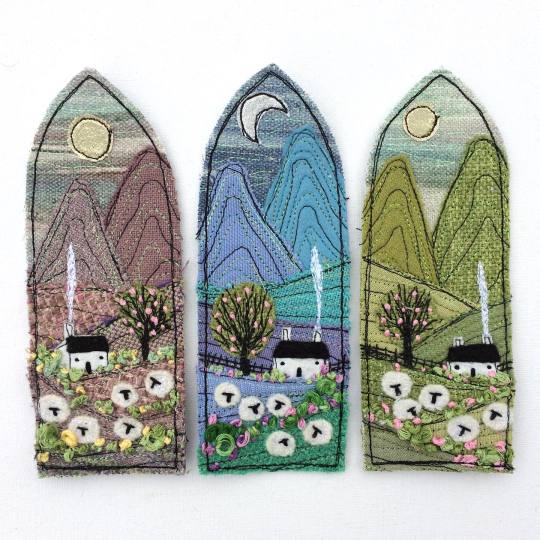
Textile Artist: Karen Pleass
8 notes
·
View notes
Text
youtube
Every year, nearly 100 billion items of clothing are produced – and 65% of them end up in a landfill within 12 months. New technologies in textile recycling may be able to curb that waste – while producing a host of sustainable materials.
#planeta #recycling #fastfashion #circulareconomy #textileindustry
We're destroying our environment at an alarming rate. But it doesn't need to be this way. Our new channel Planet A explores the shift towards an eco-friendly world — and challenges our ideas about what dealing with climate change means. We look at the big and the small: What we can do and how the system needs to change. Every Friday we'll take a truly global look at how to get us out of this mess.
Follow Planet A on TikTok: https://www.tiktok.com/@dw_planeta?la...
Credits:
Report: Dave Braneck
Video Editor: Frederik Willmann
Supervising Editor: Michael Trobridge
Fact Check: Alexander Paquet
Thumbnail: Ém Chabridon
Read More:
McKinsey - Scaling Textile Recycling in Europe
https://www.mckinsey.com/industries/r...
NY Times - Will We Ever Be Able to Recycle Our Clothes Like an Aluminum Can?
https://www.nytimes.com/2022/11/30/st...
EU Strategy for Sustainable and Circular Textiles https://environment.ec.europa.eu/stra...
Chapters:
00:00 Intro
00:46 Textile waste's global impact
02:47 How do you actually recycle clothes?
03:50 New approaches to textile recycling
07:41 What else needs solving?
11:41 Can we even recycle all the clothes we make?
#DW Planet A#solarpunk#fashion#fashion industry#fast fashion#fashion waste#circular fashion#recycling#textiles#textile industry#sustainable fashion#sustainable textiles#textile recycling#Youtube
7 notes
·
View notes